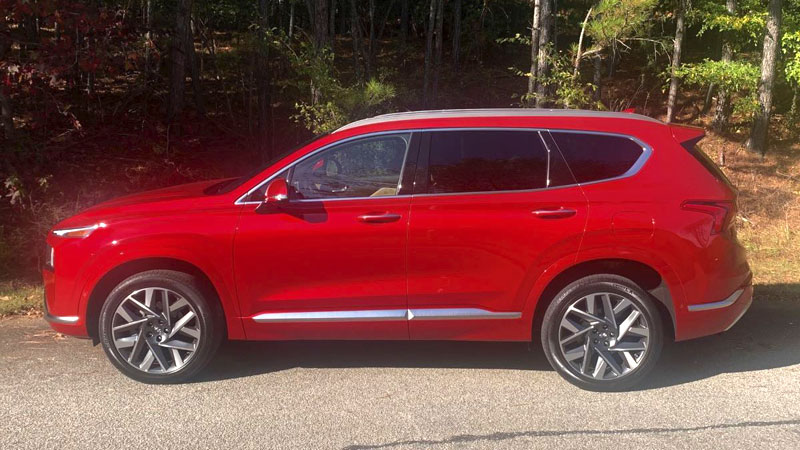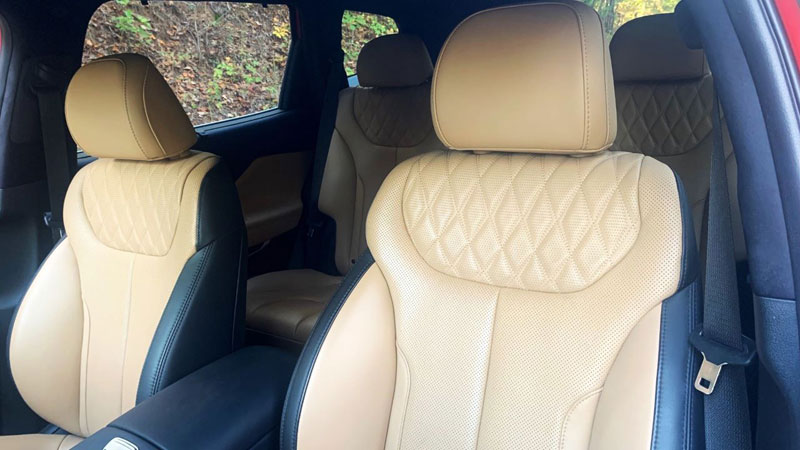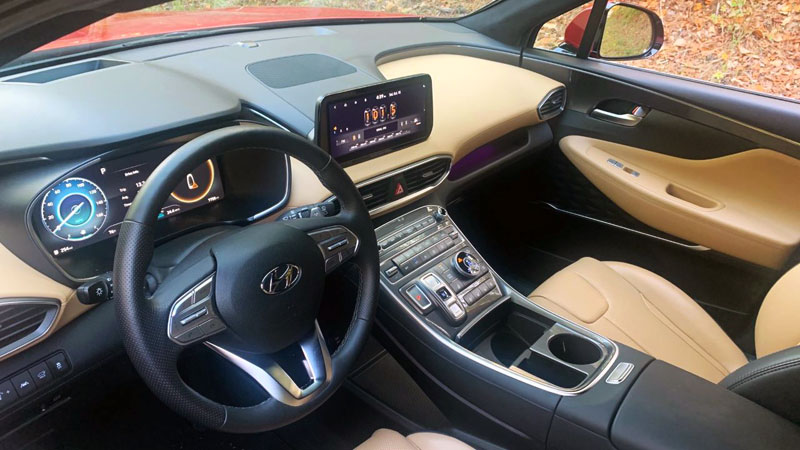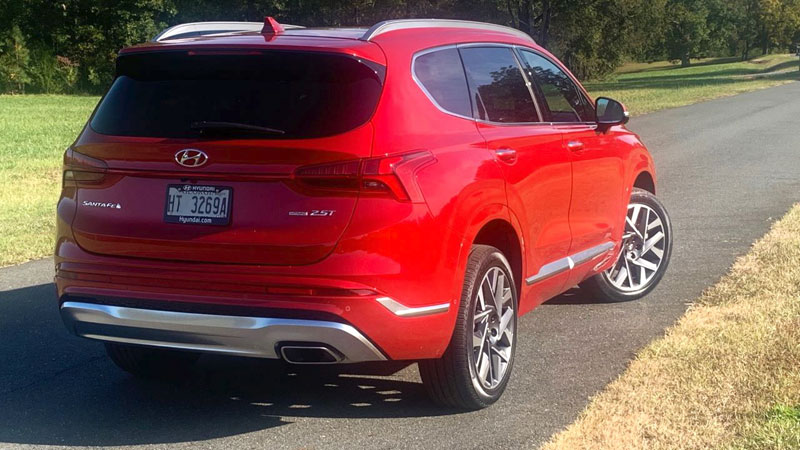
2023 Hyundai Santa Fe Review (a Practical, Affordable SUV)
The Hyundai Santa Fe blends style, comfort, and efficiency to deliver an affordable midsize crossover utility vehicle with room for five.
This SUV sits between the Tucson and Palisade, offering more room than the former, and better maneuverability than the latter. Most shoppers will choose the gas model, but a pair of hybrid options are worth considering.
2023 Hyundai Santa Fe Review
Hyundai offers the 2023 Santa Fe in 10 grades across its gas, hybrid, and plug-in hybrid (PHEV) lines. The gas models offer standard front-wheel drive and available all-wheel drive. The hybrids come with all-wheel-drive only.
The gas Santa Fe comes in five grades – SE ($28,200), SEL ($31,900), XRT ($33,700), Limited ($40,050), and Calligraphy ($42,050).
The Santa Fe Hybrid is available in three grades – Blue ($34,300), SEL Premium ($38,360), and Limited ($40,170).
The PHEV comes in a pair of grades – SEL Convenience ($40,000) and Limited ($46,010). A federal tax credit of $6,587 accompanies the PHEV and is available to eligible buyers. Check with your accountant to determine eligibility. Add $1,295 for the freight charge.
For this review, we will concentrate on the gas model, while mentioning the powertrain choices with the hybrids.
Exterior Remarks

Bold front fascias are nothing new. But what Hyundai does to the Santa Fe’s nose is far from subtle. Indeed, at first glance, you may not notice what the styling conveys, but we see a definite shark face present. Yes, that certainly is a matter of opinion, but we will stick with that.
In any case, the Santa Fe’s face features a massive grille with integrated lighting elements that projects confidence and strength. This SUV’s profile is not as dramatic, although multiple character lines, body sculpting, and brightwork trim add verve.
The rear fascia is far calmer than the front with an attractive light bar connecting the rear lighting elements.
The SE grade comes with LED lights and 18-inch alloy wheels. Begin your search with the SEL grade and more features become standard or available. These include heated side mirrors, rain-sensing wipers, a power liftgate, a panoramic sunroof, and roof side rails.
The XRT grade offers several unique styling cues including side steps and black trim.
Interior Highlights

The midsize two-row utility vehicle segment offers an excellent place for families to start their search. Especially those with teens who need room to spread out. The Santa Fe competes with the Ford Edge, Nissan Murano, Honda Passport, and Chevrolet Blazer for customer attention.
All models in this segment seat five adults comfortably and offer generous cargo capacity. In the Santa Fe’s case that represents 36.4 cubic feet or 72.1 cubic feet with the rear seat folded.
The front seats are comfortable with ample back and hip support. The driver’s front forward vision is excellent, while large rear windows make it easy to see along the sides. The rear seats recline, a welcome feature on long trips.
Traditional knobs and buttons control most cabin and infotainment features. Even the transmission shifts with buttons, freeing up space around the steering column accordingly. There is no lack of storage compartments, drink holders, and cargo trays available. Outside of a minivan, which Hyundai does not sell, the Santa Fe is as versatile as they come.
Cloth seats dress the SE, SEL, and XRT grades. The Limited features leather, while the Calligraphy is wrapped in quilted Nappa leather that punches above this model’s weight.
All but the base model features an 8-way power driver’s seat with lumbar support; most grades also offer a power-controlled front seat. Heated and ventilated front seats, heated outboard rear seats, and a heated steering wheel are available.
Technology Features

Most Santa Fe models come with a 12.3-inch digital instrument cluster presentation. An 8-inch touchscreen display is standard; a 10.25-inch layout is available. A 6-speaker audio system, HD Radio, four USB ports, Bluetooth, wireless Apple CarPlay, and connected Android Auto are standard.
Move up through the grade range and a 12-speaker Harman Kardon audio system becomes available. Navigation and a wireless charging pad are other features of note. Choose the Calligraphy grade and this one has a full-color heads-up display.
We found the center display intuitive and easy to use. That said, some drivers may find the panel pushed deeper into the dashboard than they are comfortable with.
Safety Features
Hyundai offers a strong roster of driver-assist safety tech. All grades come with adaptive cruise control with full stop-and-go. The base grade includes forward collision-avoidance assist with pedestrian, cyclist, and junction turning detection.
Lane-keeping assist, lane-following assist, and driver attention warning are also standard.
Beginning with the SEL grade, Hyundai adds blind-spot collision avoidance, rear cross-traffic collision avoidance assist, and safe exit assist. Parking distance warning and a blind-spot view monitor with a surround-view monitor are optional.
Powertrain Choices
A 2.5-liter four-cylinder engine powers every Santa Fe gas model. With the SE, SEL, and XRT grades, it is naturally aspirated and has an output of 191 horsepower and 181 pound-feet of torque.
The Limited and Calligraphy grades gain turbocharger technology, with 281 horsepower and 311 pound-feet of torque. The first engine works with an 8-speed automatic. The turbo pairs with an 8-speed dual-clutch transmission (DCT).
Consider either hybrid model and each comes with a 1.6-liter turbocharged four-cylinder engine mated to a 6-speed automatic transmission and a hybrid system. A net 226 horsepower with the conventional hybrid and 260 horsepower with the PHEV combine with efficiency to deliver solid alternatives to the gas model.
When properly equipped, models outfitted with the standard engine have a 2,000-pound towing capacity. The turbo models pull up to 3,500 pounds.
Driving Highlights

We have driven Hyundai models equipped with both 2.5-liter engines and quickly recognized the difference between the two. That said, the base engine delivers a fair amount of power, although the engine becomes noisy under hard acceleration.
We believe that under a full load the standard engine will work hard to pull more than two tons of mass and payload. Kudos to Hyundai for the smooth-shifting eight-speed automatic transmission as it manages gear changes with ease.
Our test model came with the turbo engine and the difference was noted from the onset. This engine delivers superior step-off acceleration and strong passing power. The turbo spools quickly with minimal lag.
We have seen comments that the eight-speed dual-clutch transmission supplies choppy shifts. That was not our experience, but it is something to keep in mind.
The Santa Fe supplies a composed driving experience with a comfortable and quiet ride. Generous amounts of insulation quell road noise.
The Santa Fe does not hug the road like some performance-oriented models with the usual amount of body lean while navigating twisty roads. But it is easy to maneuver and that is important in an urban environment.
Hyundai Santa Fe Considerations
With gas, hybrid, and PHEV models to consider, the Santa Fe line offers more choices than any of its competitors. The PHEV with its federal tax credit alone makes for a compelling choice, especially with the standard SEL Convenience grade costing $40,000.
Still, we believe the SEL gas model offers many of the amenities customers want at an attractive cost. Opt for all-wheel drive and this version costs $33,600, including the freight charge.
Photos copyright Auto Trends Magazine. All rights reserved.
